As an Amazon Associate, we earn from qualifying purchases with no additional costs for you.
Knife sharpening stones, or whetstones, come in such a wide variety that it can be challenging to choose the best stone to sharpen your knives. Understanding each type of whetstone helps to make the right decision to get the best results on your knife edge, and in many cases, it will be a combination of stone types.
Knife sharpening stones are available in various materials and use different lubricants or no lubricants at all. The main stone types are oil stones, water stones, diamond stones, and ceramic stones. Each stone type has characteristics that make them ideal for certain knife-sharpening tasks.
Whetstones have been used for centuries to sharpen knives, tools, and weapons of war, and these sharpening methods have become even more effective with advancements in materials and technology. We explain each stone type so you can compare their qualities and choose the best sharpening tool for your needs.
If you are interested in buying some of the whetstones mentioned in this article we recommend and use regularly, you can find them in the table below:
| Usage | Grit Type | Best Option |
|---|---|---|
| Fixing stone | 320 grit | Shapton Kuromaku 320 |
| Establishing the Edge | 400 grit | Naniwa Chosera 400 |
| Sharpening Stone | 600 grit | Naniwa Chosera 600 |
| Sharpening Stone | 800 grit | Naniwa Chosera 800 |
| Finishing Stone | 1000 grit | Suehiro CERAX |
| Polishing Stone | 2000 grit | Shapton Kuromaku 2000 |
| Polishing Stone | 5000 grit | Shapton Kuromaku 5000 |
| Extra Polishing Stone | 8000 grit | Shapton Kuromaku 8000 |
| Mirror Polishing Stone | 12000 grit | Shapton Kuromaku 12000 |

What Are The Different Types Of Knife Sharpening Stones?
There are many knife sharpening tools and sharpening systems, but all these new methods are based on the whetstone as the foundational means of knife sharpening.
Many modern sharpening systems still use whetstones technology in their methods, but the system makes the process easier for the person doing the sharpening.
Maintaining the right angle of the blade to the stone and the correct motion across the stone are the hardest parts of learning to sharpen knives on whetstones, and sharpening systems seek to reduce this hurdle for beginner knife sharpeners and pre-program these factors into the sharpening system.
The whetstone remains the primary method for getting a fantastic edge on your knife, unrivaled by many other sharpening systems. This is because sharpening freehand on a whetstone gives you the ability to feel the blade on the stone and make micro-adjustments to get the best edge.
Learning to sharpen your knives on a whetstone is the best way to sharpen them, and it is a skill well worth the time spent learning. Nothing is more satisfying than taking a dull knife and restoring it to hair-splitting sharpness freehand on a whetstone!
However, with the array of sharpening stone types available today, how do you choose the best sharpening stones? Our discussion of the different stone types will give you the details you need to decide on the best sharpening stones for your purposes.
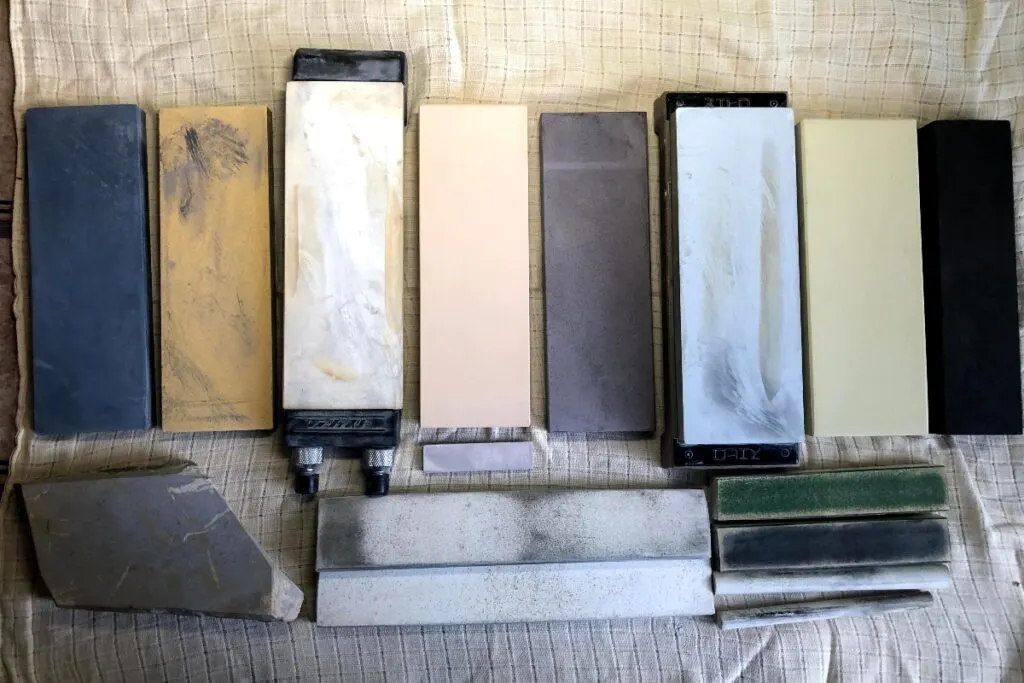
Oil Stones For Knife Sharpening
Oil whetstones are probably the first type of sharpening stone that comes to mind for beginners to knife sharpening.
Oil stones are generally divided into two categories: natural stones and synthetic stones. Historically, natural stones were the only sharpening stones available and were made of rock with quartz or novaculite as its primary ingredient.
This type of stone was common in the regions ruled by the Ottoman or Turkish empire, and there are large deposits in the Ouachita mountains located in Arkansas, USA. This has led to many natural stones being referred to as Arkansas stones, and some quality sharpening stones come from this region.
There are various other natural stones that are a combination of rock types, such as various forms of sandstone and quartz.
Natural stones work very well and are of excellent quality, but they are relatively expensive, especially when compared to synthetic stones.
Synthetic stones are more readily available and are cheaper than natural stones. These stones are made from manmade bonded abrasives, such as aluminum oxide or silicon carbide.
Synthetic stones are generally better than most natural stones because of the consistent grain structure in the material. Synthetic stones have more grit variations, cut faster, and cost less than natural oil stones.
| Feature | Natural Stones | Synthetic Stones |
|---|---|---|
| Variety of grit sizes | ✓✓✓ | ✓✓✓✓✓ |
| Grit consistency through the stone | ✓✓ | ✓✓✓✓✓ |
| Cutting effectiveness | ✓✓✓✓ | ✓✓✓✓✓ |
| Ease of availability | ✓✓ | ✓✓✓✓ |
| Cost | $$$$$ | $$$ |
Comparison: Natural vs. Synthetic Sharpening Stones
Synthetic stones have become the oil stone of choice for knife owners due to their better performance at a lower cost.
Oil stones should be used with oil formulated for low viscosity to lift and wash the swarf from the stone during sharpening. This prevents the stone from clogging and keeps it effective at sharpening the knife’s edge.
Some stones can be used with water or oil, but some are designated for use with oil only. The manufacturer will indicate which lubricant is best for use with the stone. We have an article, “Use These Oils With Your Sharpening Stone,” to help you choose the right oil for knife sharpening.
If you choose to use oil with a sharpening stone, you must continue to use oil with that stone. You cannot change to a different lubricant after using oil on the stone.
Oil stones work well but do not cut as fast as some of the other sharpening stone types, and they are messier to use than other stones, making them less favored by many knife owners.
The need for oil as a lubricant also makes oil stones less suitable as a portable, in-field knife sharpening option.
TIP: The naming of various types of stones and the incorrect use of the names of the stones have contributed to further confusing an already confused issue. Check out the differences between oil and water stones in the article below:
Oil Stone Vs. Water Stone: What’s The Difference?
Water Stones For Knife Sharpening
In order to clear up some terminology in knife sharpening, some definitions are in order. A whetstone is not necessarily a waterstone, but a waterstone is a whetstone.
The word “whet” is an old English word that means to sharpen. Hence, a whetstone is any stone used to sharpen knives, tools, or other edged implements.
Consequently, all water stones are whetstones, but not all whetstones are water stones!
Water stones, like oil stones, can be made from natural stone or synthetic materials. The more common and easily available stones are synthetic stones, but some natural stones, such as Japanese Waterstones, are highly valued and sought after.
Japanese Waterstones are made from natural rock with an exceptionally even grain structure, but they are a limited resource, which makes them very pricey.
Synthetic water stones are made from aluminum oxide or silicon carbide, similar to oil stones, but the difference between the two stones is in the binder material used to hold the abrasive material.
Water stones are made with a softer binder material, which makes the stone wear faster, but it also makes the stone cut the steel more effectively. As the binder material wears faster, it reveals fresh abrasives beneath, making the stone’s cutting ability better than oil stones.
The main disadvantage of water stones compared to oil stones is that water stones wear out faster than oil stones. Water stones are less messy to use than oil stones and can easily be used as a portable or in-field sharpening option. Just add water.
Water stones are easily sourced and are probably the most popular whetstone for sharpening knives due to their effectiveness and relatively low cost. The lower cost makes these stones more accessible to a wider range of people, contributing to their widespread popularity.
TIP: Whetstones are the best choice over manual or electric sharpeners, but they take time to master. Find out the main reasons why whetstones are better than any other sharpener in the article below:
5 Reasons Why Whetstones Are Better Than Any Sharpeners
Diamond Plates To Sharpen Knives
Diamond plates are another sharpening stone format used for sharpening knives. Diamond stones, or diamond plates, come in a variety of shapes, sizes, and grit levels.
The diamonds used to make these sharpening stones are synthetic diamonds made in a chemical process rather than natural diamonds, which are too rare and expensive to be used in sharpening stones.
Diamond stones come in two forms. The first is a thin metal sheet, usually with small round holes in the sheet. Diamond fragments are embedded in the surface of the thin metal, and the sheet is then bonded to a backing board, usually made from durable plastic.
This style is known as an interrupted surface diamond plate due to the holes in the surface. The purpose of the holes is to remove the swarf from the work surface, prevent clogging, and keep the sharpening effective. The swarf falls into the holes, where it is below the sharpening surface of the plate.
The second form of a diamond plate is a solid surface plate, usually made from aluminum. The diamond abrasive is embedded in the upper surface of the metal. The plate is solid, resembling other whetstones in appearance, and has no surface holes like the interrupted surface plates.
Diamond stones have the best cutting ability of all whetstones, making them the fastest and most effective stones, especially in low grits for knife-edge repair.
Interrupted surface diamond plates can be used without water as a lubricant and used completely dry. This makes them a common option for survival or field sharpeners.
Solid plate diamond sharpeners need water as a lubricant to remove the swarf from the plate surface. Oil should not be used as a lubricant on interrupted surface or solid surface diamond sharpening plates.
Many experienced knife sharpeners prefer to use high-quality water stones for honing or finishing a sharp edge on a knife after sharpening on diamond stones. This is because the diamond abrasive is too aggressive and does not leave as fine an edge on the knife at higher grit levels.
One of the most significant advantages of diamond stones is that they do not wear unevenly or cup as the other stones do. Diamond stones provide a constant, absolutely flat, sharpening surface that does not require flattening.
This characteristic makes diamond stones better for precision work and creates an even edge across the length of the blade.
One of the main disadvantages of diamond stones is the price. They are more expensive than most oil or water stones but have a longer, usable lifespan.
TIP: Diamond sharpening stones can be expensive, but the higher-end stones offer better value for money than cheap stones. Check out the best ones in the article below:
Buyer’s Guide: Best Diamond Knife Sharpening Stones Set
Ceramic Or Glass Stones For Knife Sharpening
Ceramic sharpening stones are made from particles of a very hard material called zirconia dioxide. This synthetic ceramic material is extremely hard-wearing and works very well for refining an edge on a knife.
The ceramic material is sometimes referred to as glass, which is why the terms glass and ceramic are interchangeable for these stones, but they refer to the same material.
The synthetic ceramic particles are combined with a bonding agent into various shapes, from honing rods to sharpening stones.
Depending on the bonding agent used, the ceramic stone can be used with water as a lubricant or with no lubricant. Oil should not be used as a lubricant on ceramic or glass whetstones.
The manufacturer of the ceramic stone will stipulate where the stone can be used dry or whether water is required when using the stone.
Ceramic sharpeners are not generally made in lower grits but are only available in medium and fine grits. This makes ceramic sharpeners ideal for honing or refining a sharp edge on a knife, but they are not as effective for repairing a damaged edge.
Ceramic stones are very flat and have an even grit throughout the stone, making them very precise and capable of creating a uniform, refined edge on the blade.
Ceramic stones can be cost-effective, but better quality ceramic stones, such as the Shapton Glass series of ceramic stones, are generally more expensive than other sharpening stone options.
However, glass stones are extremely durable and will last a long time, making them value for money in the long term. The main disadvantage of ceramic stones is that they do not come in low grits and are used for honing purposes rather than sharpening.
TIP: Shapton Kuromaku stones and the glass stones both sharpen knives from 57 HRC to 62 HRC equally well. Find out a comparison between these two sharpening stones made by the well-known Shapton company in the article below:
Shapton Kuromaku Vs. Glass Stone: What Works Best?
What Are Knife Sharpening Stones Made Of?
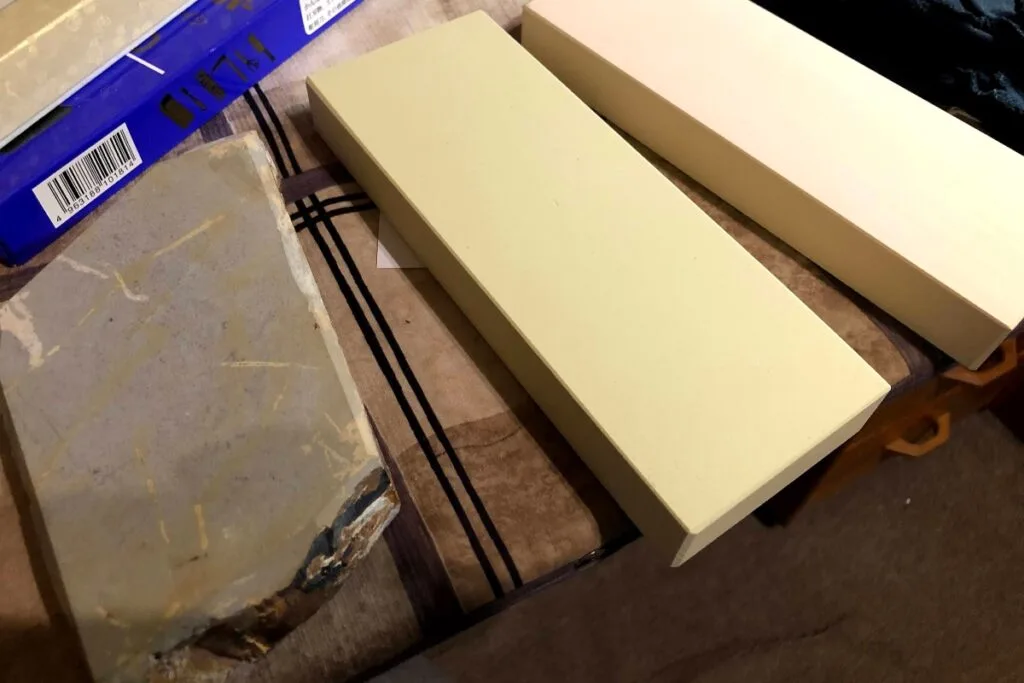
Oil and water stones are made from natural rock or synthetic materials. The use of natural materials for these stones is declining due to the limited supply and the cost of mining these materials.
Synthetic whetstone materials are easier to source, cheaper to make, and last longer than natural alternatives.
Diamond sharpening stones or plates are made from industrial or synthetic diamonds embedded in a metal surface. This plate can be a thin metal plate with a hard plastic backing or a solid metal plate in which the abrasive is embedded.
Ceramic sharpening stones are made from particles of zirconia dioxide, an extremely hard compound. These particles are manufactured industrially, so the grit sizes are highly accurate and even throughout the stone.
If you are interested in buying some of the whetstones mentioned in this article we recommend and use regularly, you can find them in the table below:
| Usage | Grit Type | Best Option |
|---|---|---|
| Fixing stone | 320 grit | Shapton Kuromaku 320 |
| Establishing the Edge | 400 grit | Naniwa Chosera 400 |
| Sharpening Stone | 600 grit | Naniwa Chosera 600 |
| Sharpening Stone | 800 grit | Naniwa Chosera 800 |
| Finishing Stone | 1000 grit | Suehiro CERAX |
| Polishing Stone | 2000 grit | Shapton Kuromaku 2000 |
| Polishing Stone | 5000 grit | Shapton Kuromaku 5000 |
| Extra Polishing Stone | 8000 grit | Shapton Kuromaku 8000 |
| Mirror Polishing Stone | 12000 grit | Shapton Kuromaku 12000 |
What Stones Are Good For Sharpening Knives?
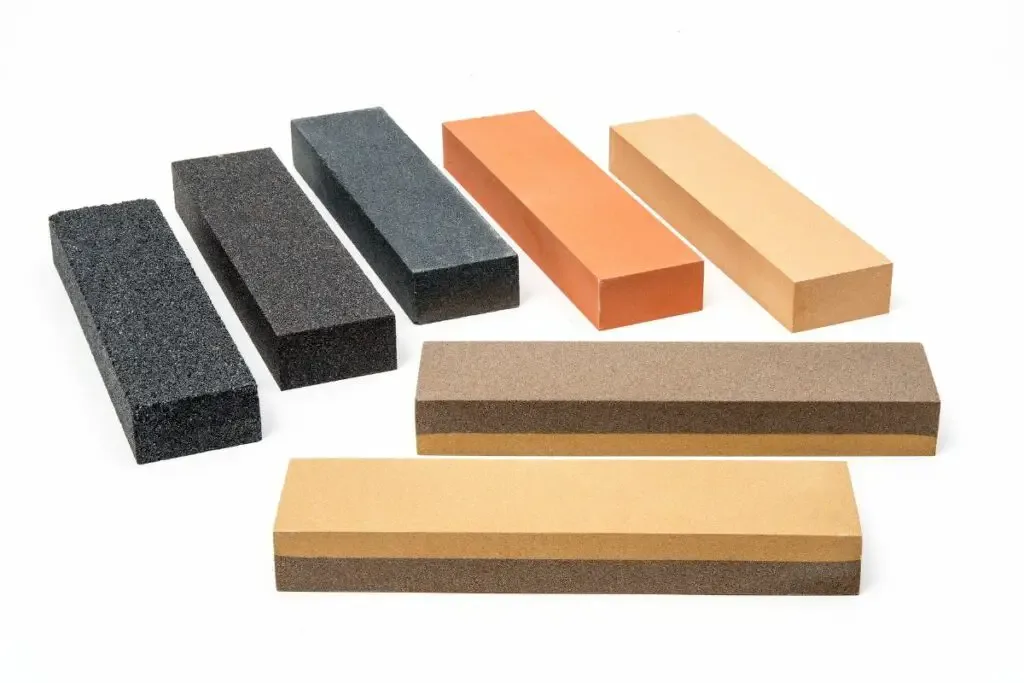
Every experienced knife sharpener will have their personal preference as to which stones are good for sharpening knives.
Essentially, oil, water, and diamond stones are all good for sharpening knives, with the only stones lacking in this department being ceramic or glass stones. Ceramic stones are best for honing rather than sharpening.
If you are looking for a portable field sharpener, the best option to carry with you is a diamond stone that can be used without water.
I think oil stones are simply too messy for my sharpening needs, so I prefer water stones to sharpen my knives. These water stones do a good job and are budget-friendly.
If money was no object, the ideal option would be to have a diamond low-grit stone for repair work, medium-grit water stones for general sharpening, and high-grit ceramic stones for honing and polishing.
TIP: When choosing whetstones, you need to balance cost, quality, and the number of stones and grits to maximize the efficiency of sharpening knives with this method. Check out the complete guide on how to choose in the article below:
How To Choose And Buy A Whetstone: The Ultimate Buyer’s Guide
What is the Best Stone for Knife Sharpening?
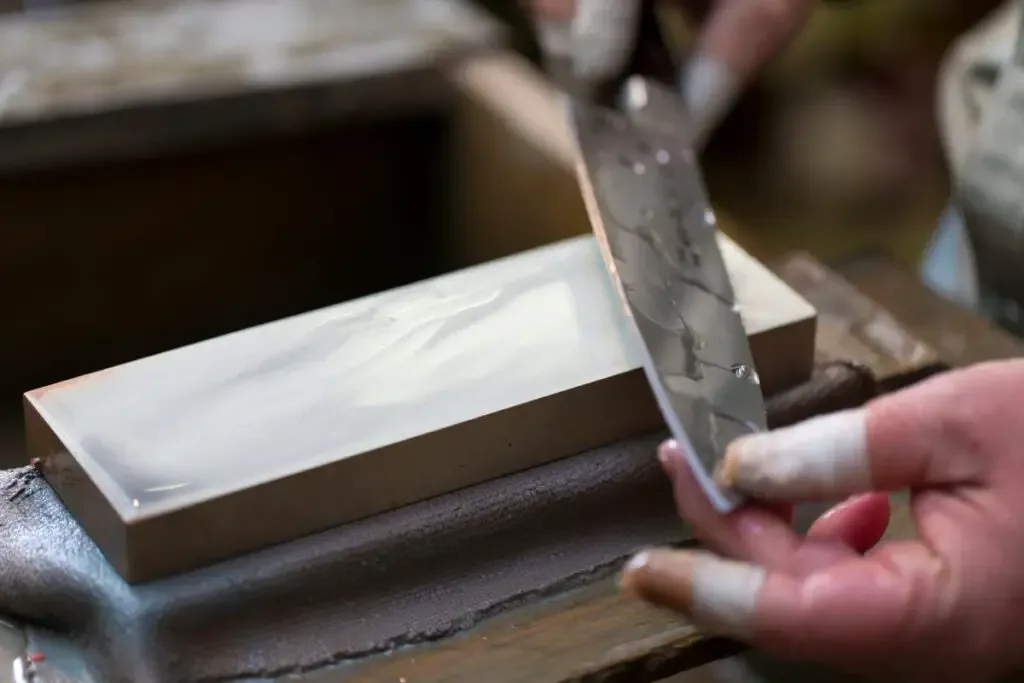
It would be beneficial to examine the characteristics of the different stones side-by-side to get an idea of the best sharpening stones for knife sharpening.
The best sharpening stone for your knife based on the task you need to do:
| Task / Feature | Oil Stone | Water Stone | Diamond Plate | Ceramic Or Glass Stone |
|---|---|---|---|---|
| Cutting ability | ✓✓ | ✓✓✓ | ✓✓✓✓ | ✓✓✓✓ |
| Ease of use | ✓✓ | ✓✓✓ | ✓✓✓✓ | ✓✓✓✓ |
| Lubricant required | Yes | Yes | Yes and No | Yes and No |
| Durability | ✓✓✓ | ✓✓ | ✓✓✓✓ | ✓✓✓✓ |
| Used for Edge Repair | ✓✓✓✓ | ✓✓✓✓ | ✓✓✓✓ | X |
| Used For Sharpening | ✓✓✓✓ | ✓✓✓✓ | ✓✓✓✓ | X |
| Used For Honing | ✓✓✓ | ✓✓✓✓ | ✓✓ | ✓✓✓✓ |
| Price | $$$ | $$$ | $$$$ | $$$$ |
The best sharpening stone for your knife
From this comparison, water stones are the most versatile and cost-effective option for a quality knife sharpening stone. However, we have not considered different environments and situations, such as portability and convenience.
For quick, in-the-field sharpening, a small diamond plate sharpener would be the most appropriate and the best option.
Consequently, you must evaluate your knife sharpening needs to determine the best sharpening option.
TIP: Whetstone grits can seem a daunting task to understand and decide which grits will be the most beneficial for your sharpening activities. Find out a complete explanation in the article below:
Complete GUIDE About Whetstone Grit: Levels & What To Buy
Can You Use Any Stone To Sharpen A Knife?
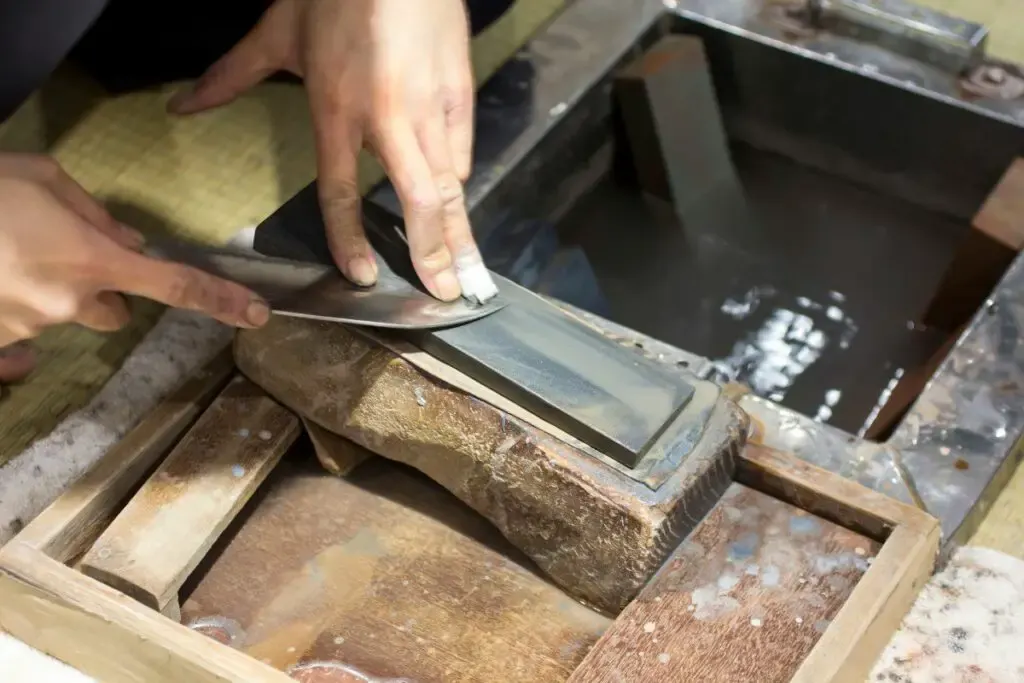
Many knife owners wonder if using any stone to sharpen a knife is possible. The simple answer is yes. You can use any stone to sharpen a knife, but you will have mixed success depending on the stone.
The best stones to use would be fine-grained stones with a flat, even surface. Water would be the best lubricant to use on these stones.
The only time I would recommend using any natural stone to sharpen a knife is if you have no other option and need to sharpen your knife right away. Some rocks and stones can do more damage to the edge than sharpening.
Mastering Sharpening Techniques
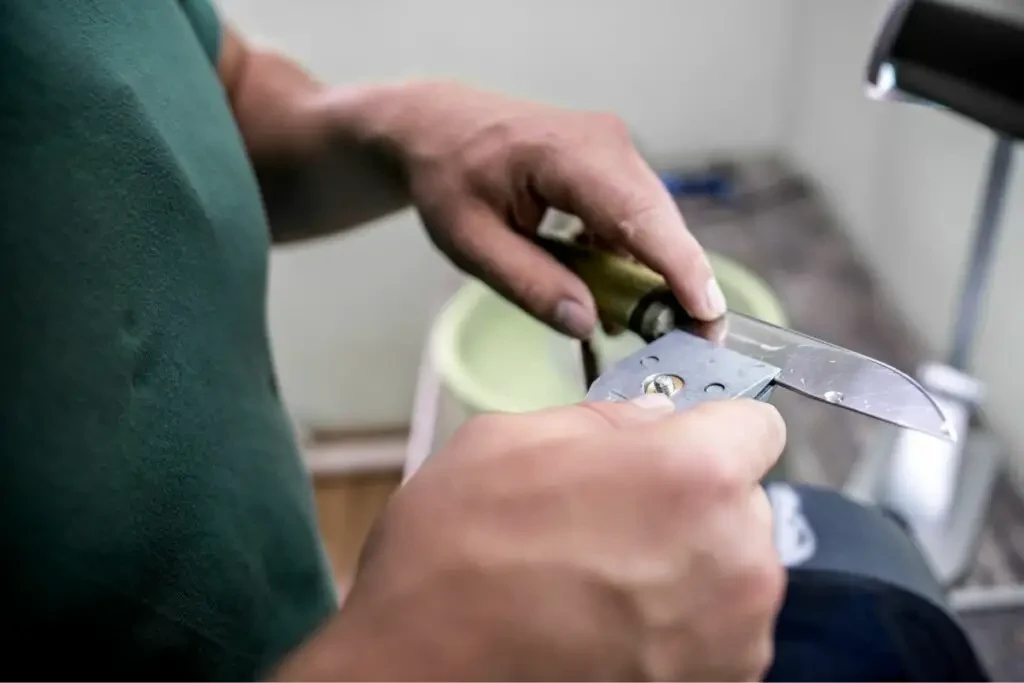
Sharpening your knives with the right technique is as crucial as choosing the appropriate sharpening stone. This section provides detailed instructions and tips to effectively use each type of sharpening stone, along with step-by-step guides, common mistakes to avoid, and maintenance tips.
1. Using Oil Stones
Preparation: Begin by applying a few drops of honing oil on the stone’s surface. This oil helps carry away the metal filings (swarf) and maintains the stone’s effectiveness.
Technique: Hold the knife at a consistent angle (usually 20-30 degrees) to the stone. Use even strokes, pushing the blade away from you as if you’re trying to shave off a thin layer from the stone.
Common Mistakes: Avoid using too much pressure, which can damage the blade and the stone. Also, ensure not to change the angle during sharpening, as this leads to an uneven edge.
Maintenance: Clean the stone after every use with honing oil and a soft cloth. Store it in a dry place to prevent any oil residue from solidifying.
2. Utilizing Water Stones
Preparation: Soak the water stone in water for about 10-15 minutes before use. The water acts as a lubricant and helps in the sharpening process.
Technique: Similar to oil stones, maintain a consistent angle. Use a combination of circular and back-and-forth motions to cover the entire edge of the blade.
Common Mistakes: Not soaking the stone long enough can lead to ineffective sharpening. Also, uneven pressure can cause the stone to wear unevenly.
Maintenance: Rinse the stone after use and let it air dry. Flatten the stone regularly to maintain its effectiveness.
3. Sharpening with Diamond Stones
Preparation: Diamond stones often don’t need any lubricant, but a little water can be used to reduce heat from friction.
Technique: Use gentle, consistent strokes while maintaining the blade’s angle. Diamond stones cut quickly, so fewer strokes are often needed.
Common Mistakes: Applying too much pressure can quickly wear down the diamond coating. Also, avoid twisting or turning the blade on the stone.
Maintenance: Clean with water and a soft brush. Store in a protective case to avoid chipping the diamond surface.
4. Handling Ceramic Stones
Preparation: Some ceramic stones require water, while others are used dry. Follow the manufacturer’s instructions for preparation.
Technique: Use light, even strokes while maintaining a consistent angle. Ceramic stones are great for honing and finishing.
Common Mistakes: Avoid dropping ceramic stones as they are brittle. Also, do not use them for heavy-duty grinding as they are less aggressive than other stones.
Maintenance: Wash with water and a mild detergent. Dry thoroughly before storing.
General Tips for All Stone Types
Angle Consistency: Use an angle guide if you’re a beginner. Consistency is key to a sharp and durable edge.
Even Pressure: Apply even pressure throughout the stroke, and don’t press too hard.
Regular Maintenance: Keep your stones flat and clean for optimal performance.
Practice: Sharpening is a skill that improves with practice. Start with less expensive knives to hone your technique.
By following these techniques and tips, you can ensure that all your knives are always sharp and your stones remain in good condition for years to come.
Remember, the art of sharpening is a blend of skill and patience, and with each stroke, you’re not just sharpening a blade, but also refining a craft.
Conclusion
Most commercially made knife sharpening stones do a good job at sharpening knives, but some are better at certain aspects of sharpening than others.
The overall best sharpening stone for knives, in my opinion, is water stones. They are affordable and create less mess. Waterstones are available in a wide range of grits and cut knife steel efficiently!
TIP: People new to knife sharpening may be undecided on what oil to use when sharpening a knife and whether oil is the best option. Find out a complete guide in the article below:
Use These Oils For Your Sharpening Stone (Explained Why)
